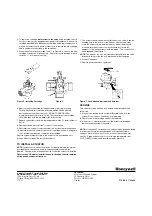
4. To replace a cartridge,
isolate flow to the valve
using installed shut off
valves or other service equipment designed for this purpose. Remove old
cartridge with 40007029-002 wrench supplied with the replacement unit.
It
may be necessary to use pliers or other tools to remove the old cartridge
due to calcium or dirt buildup in the valve body.
5. Clean the valve surfaces marked
*
and
**
in Figure 6 to ensure the new
cartridge O-rings seal at these points. Use care to avoid damage to these
surfaces ( ** for 3-way valves only).
6. Remove the pre-lubricated cartridge assembly from its plastic bag.
Thread it by hand into the valve body and tighten it down with the
enclosed wrench until it bottoms out. DO NOT OVER TIGHTEN:
maximum torque is 40 in-lb. [4.5 Nm]. The top surface of the cartridge
should be flush with the top edge of the body casting.
7. Replace valve actuator by following the procedure in the "To Install Actuator"
below.
8. Reconnect leadwires or Molex™ connector if necessary.
9. Refill hydronic system or restore system flow by opening isolating valves.
10. Restore power, and checkout operation of cartridge in valve, making sure
of no internal seat leakage or external body leakage.
Restore system pressure slowly to the valve to allow any trapped air to
escape. Check for leaks. Re-install the actuator.
TO INSTALL ACTUATOR
NOTE:
Installation of a new actuator does not require draining the system,
provided the valve body and valve cartridge assembly remain in the
pipeline. Wiring may be done either before or after the actuator is installed.
Refer to the VC Actuator Installation and Instruction sheet for detailed
wiring and check-out instructions.
1. The actuator head is automatically latched to the valve. Align the
coupling hole in the bottom of the actuator with the valve stem.
Press the actuator down towards the body with moderate hand
force and turn the actuator counter-clockwise by 1/8 turn (45
degrees) to line up the actuator with the piping. The lock will click
when engaged (See Figure 7).
NOTE:
The actuator can also be installed at right angles to the valve
body but in this position the lock mechanism will not engage.
2. Connect leadwires.
3. Restore power and check operations.
Figure 7 - Lock Mechanism to detach Actuator
Figure 5 - Installing Cartridge Figure 6
SERVICE
This valve should be serviced by a trained, experienced service
technician.
1.
If the valve is leaking, drain system
OR
isolate valve from the
system. Do not remove valve body from plumbing.
2.
Check to see if the cartridge needs to be replaced.
3.
If the motor or other internal parts of the actuator is damaged,
replace the entire actuator assembly.
NOTE:
Honeywell VC series hydronic valves are designed and tested
for silent operation in properly designed and installed systems.
However, water noises may occur as a result of excessive water
velocity. Piping noises may also occur in high temperature (over
212
o
F [100
o
C]) systems with insufficient water pressure.
Automation and Control Solutions
Environmental Control Products
1985 douglas Drive North
Golden Valley, MN 55422-3992
U.S.A.
In Canada:
Honeywell Limited-Limitee
35 Dynamic Drive
Toronto, ON M1V 4Z9
Canada
Printed in Canada






















